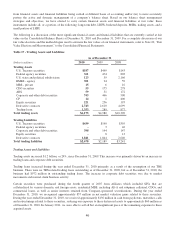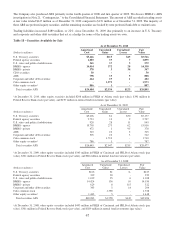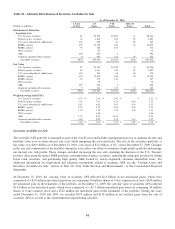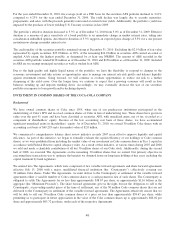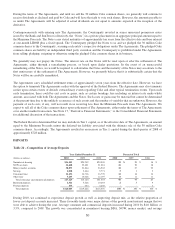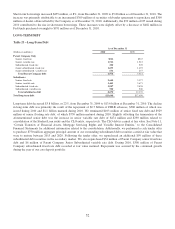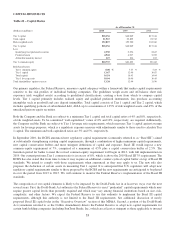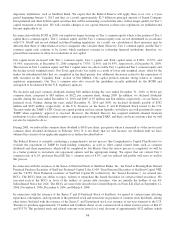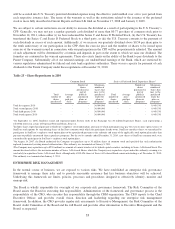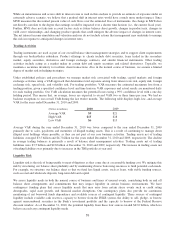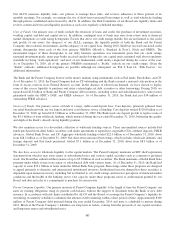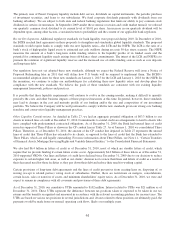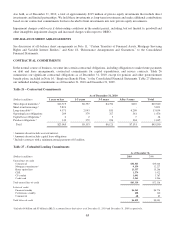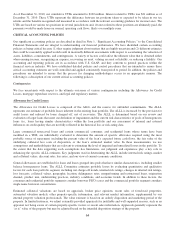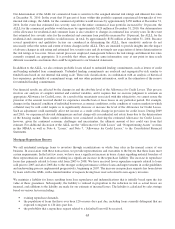SunTrust 2010 Annual Report Download - page 72
Download and view the complete annual report
Please find page 72 of the 2010 SunTrust annual report below. You can navigate through the pages in the report by either clicking on the pages listed below, or by using the keyword search tool below to find specific information within the annual report.The enterprise risk governance framework incorporates a variety of senior management risk-related committees. These
committees are responsible for ensuring effective risk measurement and management in their respective areas of authority.
These committees include: CRC, ALCO, and the EAPMC. The CRC is chaired by the CRO and supports the CRO in
measuring and managing our aggregate risk profile. The CRC consists of various senior executives and meets on a monthly
basis. The CRO is an active member of the other oversight committees.
The CRO and, by extension CRM, establishes sound corporate risk processes that focus on identifying, measuring,
monitoring, reporting and managing the risks which face the Company. At its core, CRM’s objective is to:
Deliver sophisticated risk management capabilities throughout SunTrust that:
•Identify, measure, analyze, manage and report risk at the transaction, portfolio and corporate levels;
•Optimize decision making;
•Promote sound processes and regulatory compliance;
•Maximize shareholder value; and
•Help people and institutions prosper.
To achieve this objective, we continually refine our risk governance and management limits, policies, processes and
procedures to reflect changes in external conditions and/or corporate goals and strategies. Similarly, risk management
systems, processes and applications are routinely enhanced to support our risk and business objectives. Risk information is
available at both an enterprise and a detailed level. Senior management and Board reports provide a holistic picture of the
organization’s risk profile and trends, whereas detailed information provides insight at a more granular level to line
managers. We actively work to balance our strategic goals, including revenue and profitability objectives, with the risks
associated with achieving these goals. Effective risk management is an important element supporting our business decision
making.
Organizationally, CRM measures and manages risk along four dimensions: credit risk, market risk (including liquidity risk),
operational risk and compliance/legal risk; reputational risk, which can be influenced by any of the other risk disciplines, is
also evaluated. Credit risk programs are overseen by the Chief Wholesale Credit Officer and the Chief Retail Credit Officer;
market risk programs are overseen by the Corporate Market Risk Officer; operational risk programs are overseen by the
CORO; and Compliance/Legal Risk programs are overseen by the Corporate Compliance and Regulatory Liaison Officer.
Other activities overseen by CRM include risk information and reporting; risk analytics, including stress testing and the
ALLL; and other assurance and risk administration functions.
Credit Risk Management
Credit risk refers to the potential for economic loss arising from the failure of clients to meet their contractual agreements on
all credit instruments, including on-balance sheet exposures from loans and leases, investment securities, contingent
exposures from unfunded commitments, letters of credit, credit derivatives, and counterparty risk under derivative products.
As credit risk is an essential component of many of the products and services we provide to our clients, the ability to
accurately measure and manage credit risk is integral to maintain both the long-run profitability of our lines of business and
our capital adequacy.
The Credit Risk Management group manages and monitors extensions of credit risk through initial underwriting processes
and periodic reviews which then maintain underwriting standards in accordance with credit policies and procedures. The
Corporate Risk Review unit conducts independent risk reviews to ensure active compliance with all policies and procedures.
Credit Risk Management periodically reviews our lines of business to monitor asset quality trends and the appropriateness of
credit policies. In addition, total borrower exposure limits are established and concentration risk is monitored. Credit risk is
partially mitigated through purchase of credit loss protection via third party insurance and use of credit derivatives such as
CDS.
Borrower/counterparty (obligor) risk and facility risk are evaluated using our risk rating methodology, which has been
implemented in all lines of business. We use various risk models in the estimation of expected and unexpected losses. These
models incorporate both internal and external default and loss experience. To the extent possible, we collect internal data to
ensure the validity, reliability, and accuracy of our risk models used in default and loss estimation.
56


